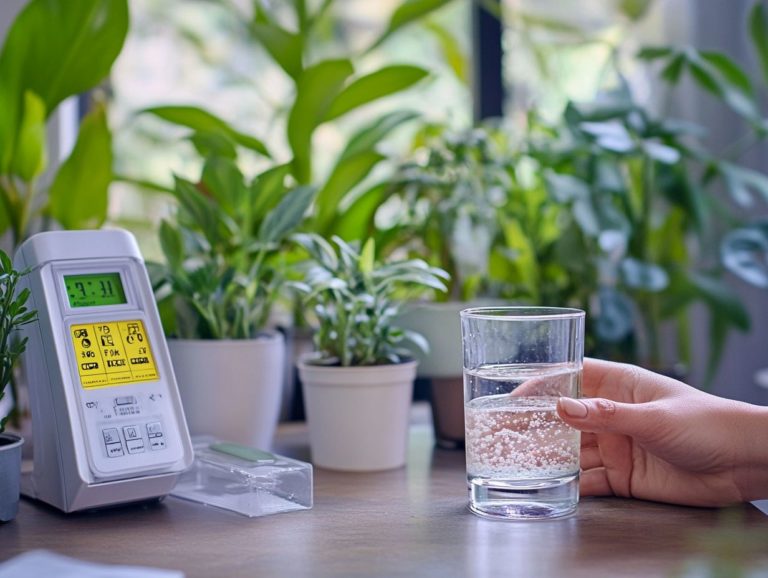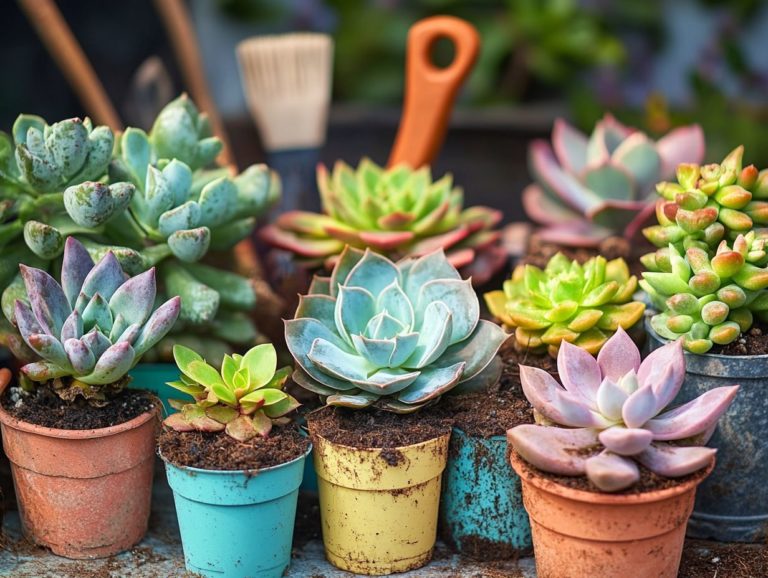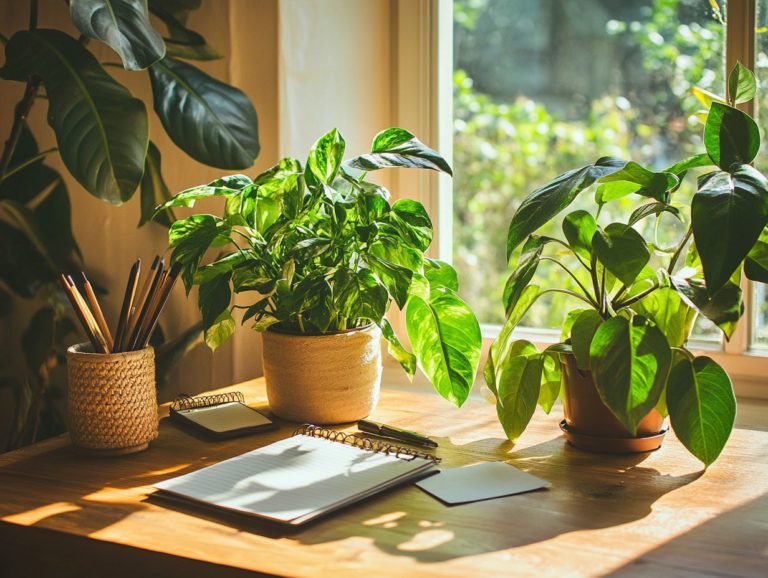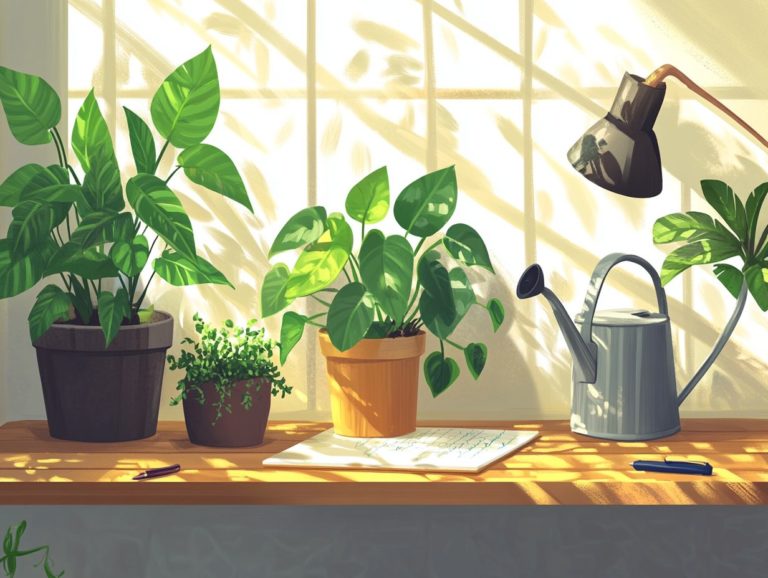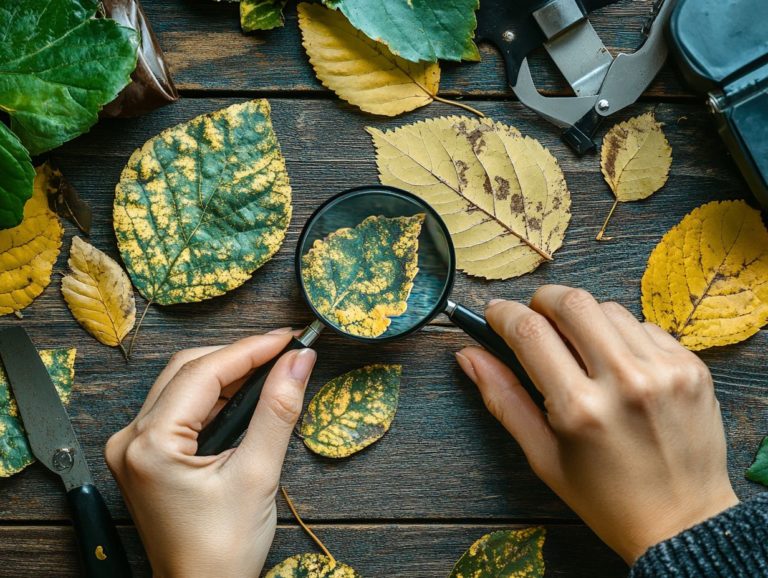Common Indoor Plant Issues: A Quick Reference
Indoor plants can add a touch of beauty and vitality to your home. However, they often encounter challenges that can impede their growth. From pests and diseases to nutrient deficiencies and environmental stressors, grasping these common issues is crucial for any plant enthusiast.
This guide will equip you with the knowledge to identify and tackle indoor plant problems, empowering you to nurture a flourishing indoor garden. Explore practical tips for effective pest control, disease management, nutrient corrections, and creating optimal conditions for your plants to thrive!
Contents
- Key Takeaways:
- Identifying and Addressing Plant Pests
- Dealing with Plant Diseases
- Preventing and Treating Nutrient Deficiencies
- Managing Environmental Factors
- Frequently Asked Questions
- What are common indoor plant issues?
- How can I tell if my indoor plant is being overwatered?
- What should I do if I suspect my indoor plant is being underwatered?
- What can I do if my indoor plant is not getting enough sunlight?
- How can I prevent pests from infesting my indoor plants?
- What are some common diseases that can affect indoor plants?
Key Takeaways:
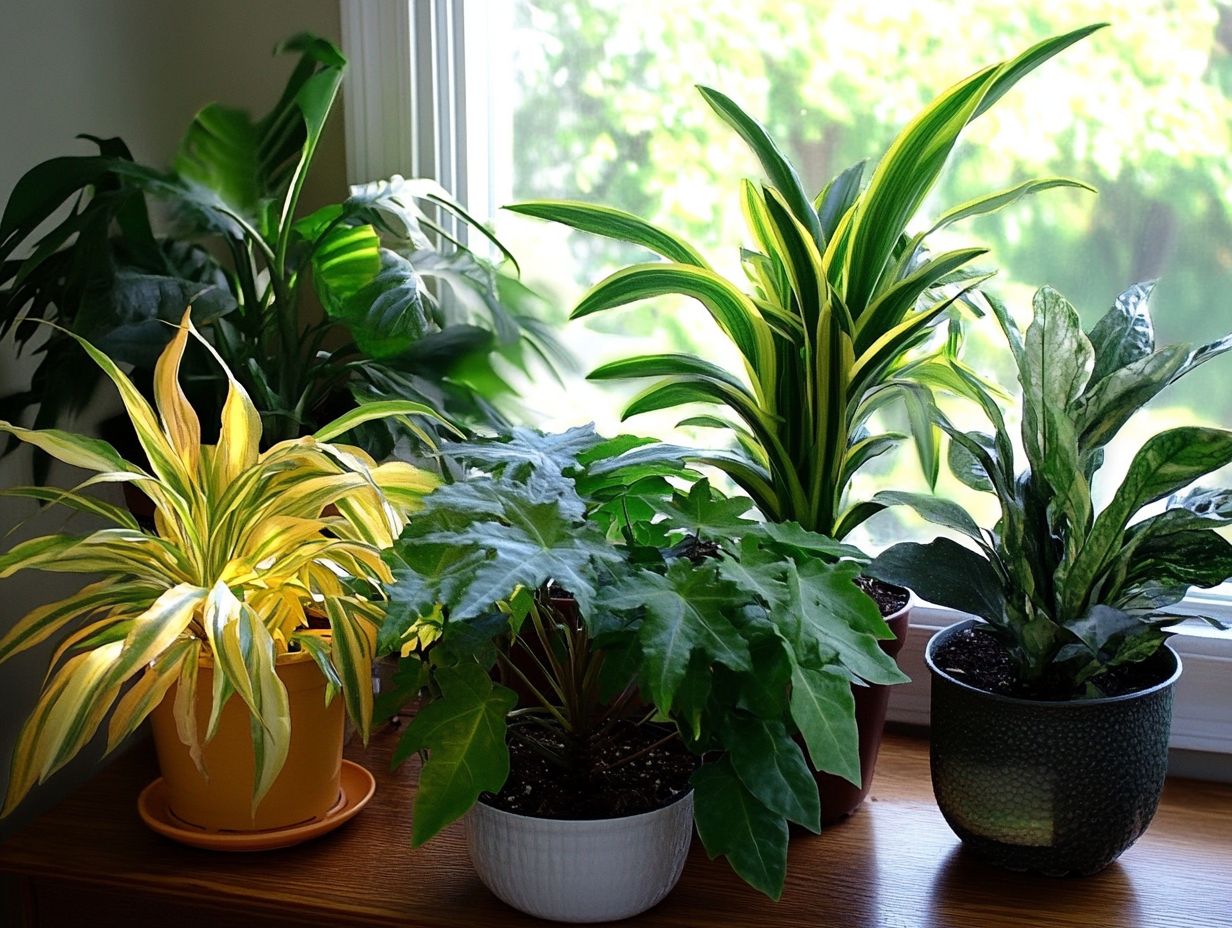
- Regularly inspect plants for signs of pests, diseases, and nutrient deficiencies to catch issues early.
- Use organic pest control methods whenever possible, such as neem oil, a natural pesticide, or diatomaceous earth, a natural insecticide made from fossilized algae.
- Maintain appropriate lighting, humidity, and temperature levels to prevent stress and promote healthy growth.
Why Do Plants Encounter Problems Indoors?
Indoor plants often face a range of challenges that can manifest as houseplant problems think yellowing leaves, dropping foliage, discolored leaf tips, distorted growth, dull colors, and weak stems. These issues usually arise from a combination of factors like overwatering, underwatering, inadequate light exposure, and humidity imbalances.
By understanding these challenges, you can create a nurturing environment that promotes healthy growth and reduces the likelihood of further issues. Inconsistent watering practices are a common culprit. For instance, plants like the peace lily and pothos are particularly sensitive to both drought and over-saturation. Adequate light exposure is equally important; low-light conditions can lead to leggy growth in snake plants or spider plants. To troubleshoot these problems effectively, consider exploring common issues in plant propagation and solutions.
Maintaining appropriate humidity levels is vital, especially for tropical varieties such as ferns and orchids, which thrive in humid environments. By addressing these specific needs, you can significantly enhance the wellbeing of your indoor greens, ultimately cultivating thriving houseplants that bring life and beauty into your space.
Identifying and Addressing Plant Pests
Identifying and addressing plant pests is essential for maintaining the health of your indoor plants. Many pests, including gnats, thrips, spider mites, and aphids, can wreak havoc, resulting in yellowing leaves and stunted growth.
Effective pest management begins with recognizing the early signs of infestation, such as tiny flying bugs, sticky residue from their feeding, or distorted growth patterns in your plants. By utilizing strategies like neem oil treatments and conducting regular inspections, you can ensure your houseplants thrive, free from the menace of pests.
Common Pests and How to Get Rid of Them
Common pests that plague indoor plants, such as gnats, thrips, spider mites, and aphids, can lead to unhealthy specimens. You might notice symptoms like yellowing leaves, lackluster color, and weak growth. To effectively combat these unwelcome visitors, it s essential to employ a multifaceted approach.
Consider using neem oil as a natural pesticide and adhering to proper plant care practices to bolster your plants’ resilience against infestations. Each pest comes with its own set of behaviors that can complicate your care routine. For instance, you ll often find gnats buzzing around the soil, while thrips leave behind silvery streaks on leaves. Spider mites may weave fine webs on the undersides of leaves, and aphids tend to cluster on new growth, sucking sap and causing distortion. Identifying these signs promptly is crucial for maintaining plant health.
Treatment options to consider include:
- Mixing neem oil with water and applying it as a preventative spray.
- Ensuring proper drainage to eliminate the damp conditions that attract gnats.
Regularly inspecting your plants and introducing beneficial insects, like ladybugs, can also significantly aid in keeping these pests at bay. Start inspecting your plants today to catch any problems early!
Dealing with Plant Diseases
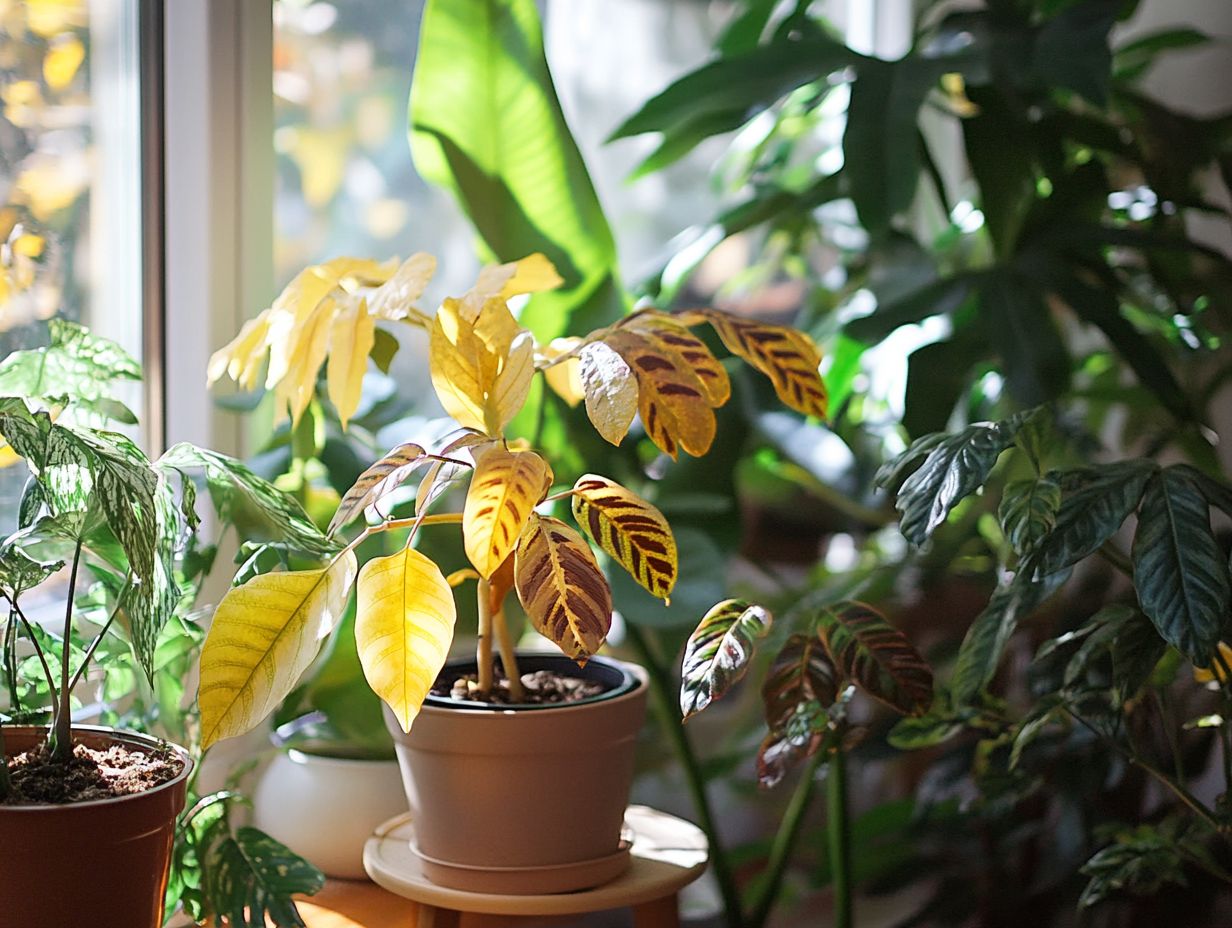
Addressing plant diseases is crucial for the long-term vitality of your indoor plants. Conditions like root rot and fungal infections, such as anthracnose, can cause significant deterioration if not tackled swiftly.
You may notice signs such as discolored leaf tips and stunted growth. These red flags indicate inadequate care or unfavorable conditions.
By using good practices to manage diseases, you can not only resolve current issues but also thwart any future outbreaks, ensuring your plants thrive in a healthy environment.
Signs and Symptoms of Common Diseases
Spotting signs of plant diseases early can save your green friends! Issues like root rot and fungal diseases can show up in various forms, such as yellowing leaves, discolored leaf tips, and weak growth. By understanding how these symptoms connect to environmental factors like humidity and moisture balance, you can significantly enhance your ability to diagnose and treat these ailments effectively.
Other symptoms, including wilting, stunted growth, and leaf spots, may signal deeper health issues that could jeopardize your plant’s vitality. For instance, common soil issues affecting indoor plants can contribute to these problems. Environmental aspects like inconsistent watering schedules, insufficient light, or poor air circulation can worsen these diseases, leading to a swift decline in plant health.
For instance, root rot happens when plant roots sit in water for too long. This can make them weak and unhealthy. To mitigate these risks, adopt proper watering techniques, improve air circulation, and adjust lighting conditions to meet your plants’ specific needs. Regularly inspecting your plants for early signs of distress enables you to take preventive measures, reducing the likelihood of disease outbreaks. For additional help, refer to this quick guide to common indoor plant issues.
Preventing and Treating Nutrient Deficiencies
Preventing and treating nutrient deficiencies in your indoor plants is essential for fostering robust growth and vibrant foliage. These plants rely on a well-balanced supply of nutrients to truly thrive.
When nutrient imbalances occur, you might notice signs like yellowing leaves and weak growth, which indicate it’s time for intervention. By monitoring soil quality, adjusting light exposure, and maintaining consistent watering practices, you can effectively meet your plants’ nutritional needs. If problems persist, consider reviewing indoor plant problems: when to seek help to help them flourish.
Recognizing and Correcting Nutrient Imbalances
Recognizing and correcting nutrient imbalances is crucial for the vitality of your indoor plants. Symptoms like yellowing leaves and weak growth often signal deficiencies in essential nutrients. By understanding the roles of these nutrients and closely monitoring environmental factors such as light exposure, you can make informed decisions about fertilization and soil amendments to restore balance.
To pinpoint specific nutrient deficiencies, keen observation is essential. For instance, magnesium deficiency might reveal itself through browned leaf edges, while nitrogen deficiency typically manifests in older leaves turning pale. Each of these deficiencies requires a tailored approach; using Epsom salts can address magnesium issues, while a nitrogen-rich fertilizer will help resolve nitrogen deficits.
Establishing a balanced feeding schedule applying fertilizers every few weeks during the growing season will support robust growth. Additionally, optimizing conditions like humidity and soil pH is vital, as these directly affect nutrient uptake. By doing so, you ensure that your plants can cultivate lush, vibrant foliage while effectively resisting disease.
Managing Environmental Factors
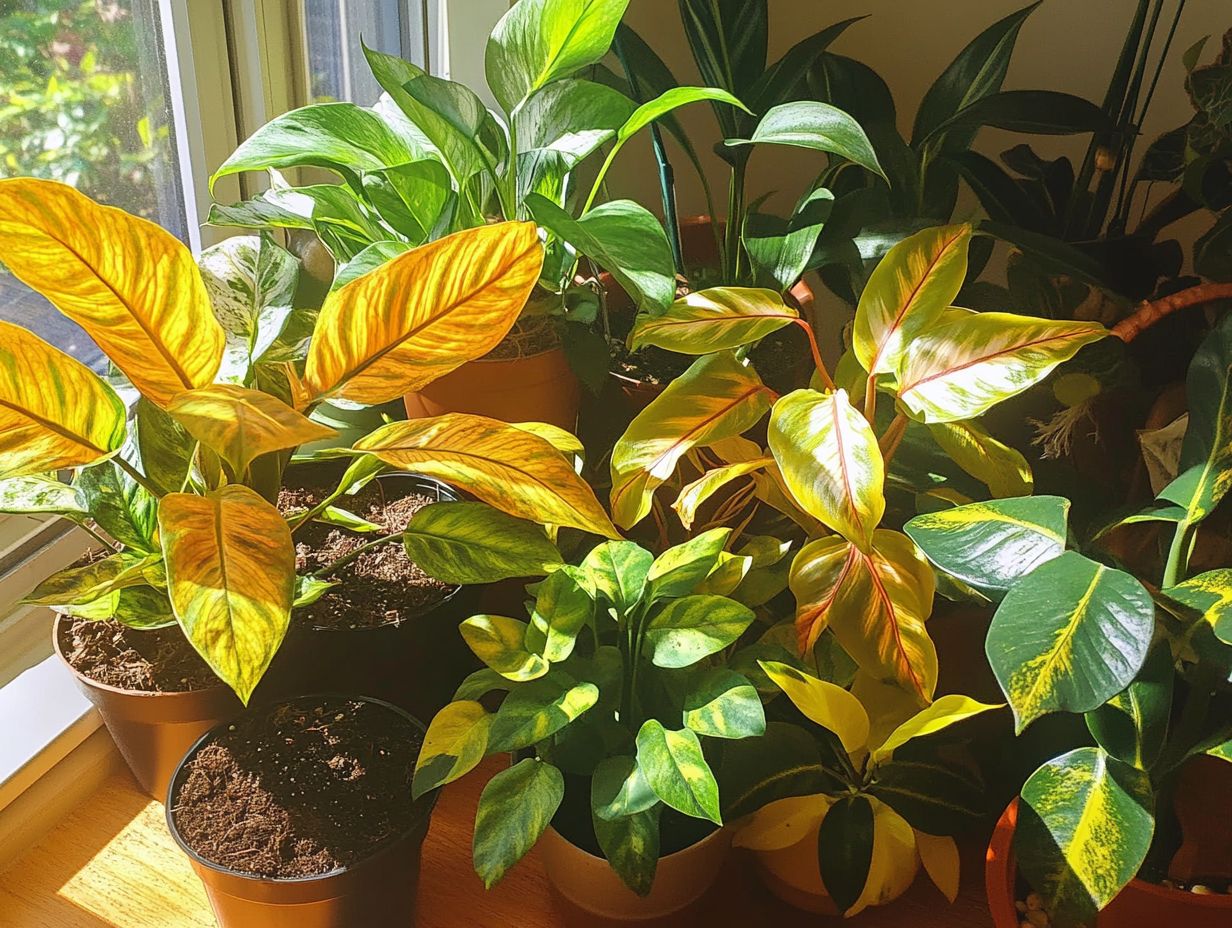
Managing environmental factors is essential for the flourishing growth of your indoor plants. Conditions like humidity, light exposure, and temperature play a pivotal role in their health and vitality.
These plants thrive in a delicate balance, and when factors such as humidity or light are off-kilter, you may notice troubling signs like yellowing leaves and stunted growth. By mastering the art of optimizing these environmental conditions, you can elevate your plant care game and witness remarkable improvements in their overall growth.
Start your journey to healthier plants today! Check your plants for signs of distress and act swiftly!
Tips for Maintaining Optimal Growing Conditions
Maintaining optimal growing conditions for your indoor plants means carefully managing humidity, light exposure, and consistent watering schedules. These factors are essential for promoting healthy growth. By understanding each plant species’ specific needs, you can create an environment that minimizes stress. This encourages vibrant foliage and robust growth.
Regularly monitoring the temperature is crucial to ensure it remains within ideal ranges for each plant type. Drastic fluctuations can lead to wilting or other negative effects you want to avoid. Using grow lights can change the game, especially during the darker months, ensuring your plants receive adequate illumination.
Investing in a tool to measure humidity will help you track levels, allowing for timely adjustments for tropical species. Regularly checking soil moisture and ensuring proper drainage significantly contributes to your plants’ overall health, fostering a nurturing atmosphere for your indoor garden!
Frequently Asked Questions
What are common indoor plant issues?
Common indoor plant issues include:
- Overwatering
- Underwatering
- Lack of sunlight
- Pests
- Diseases
How can I tell if my indoor plant is being overwatered?
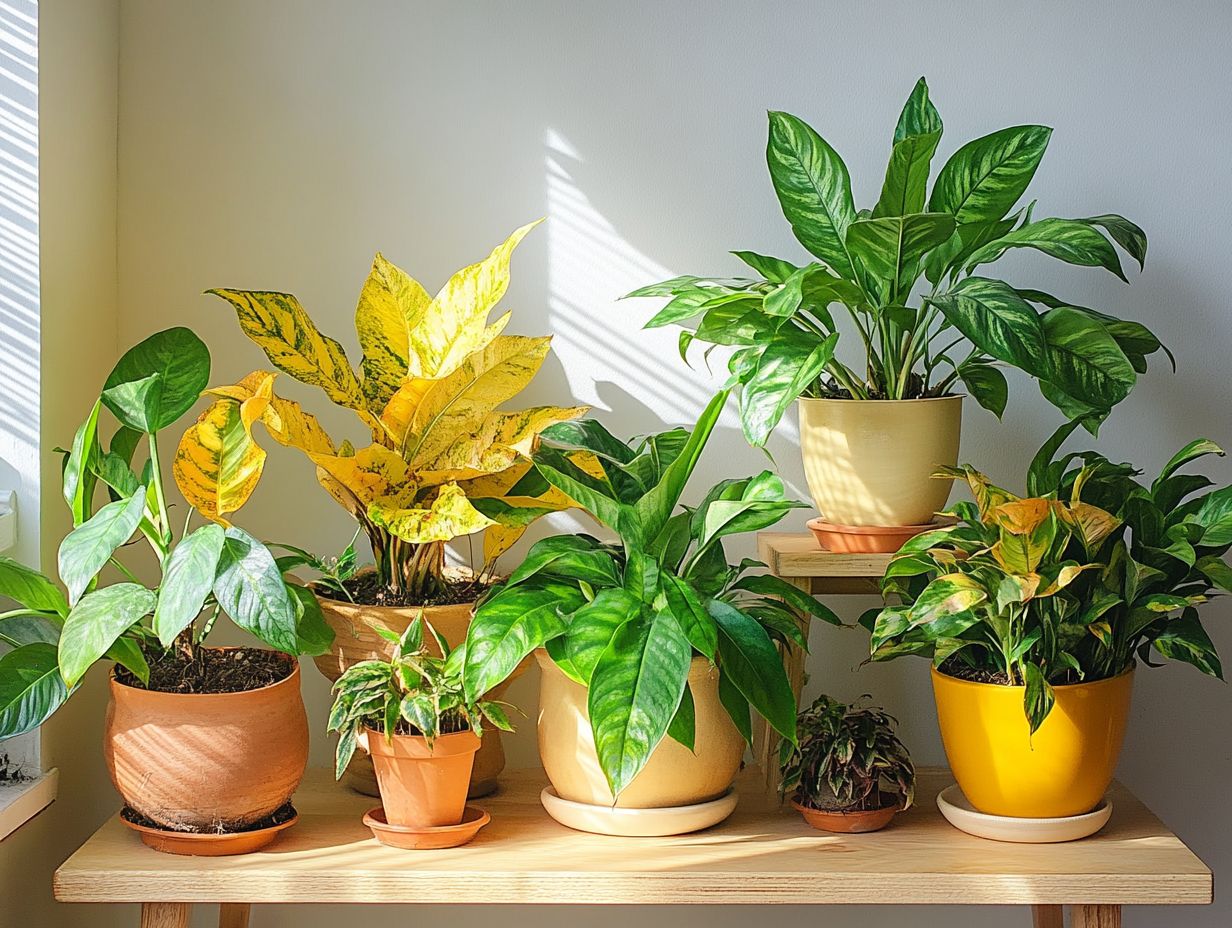
Signs of overwatering include yellowing or wilting leaves, mold or fungus growth, and a musty smell.
What should I do if I suspect my indoor plant is being underwatered?
If your plant’s soil feels dry to the touch, it may need water. Check the specific watering needs of your plant, as some may require less water.
What can I do if my indoor plant is not getting enough sunlight?
If your plant isn’t getting enough natural light, consider moving it to a brighter spot or supplementing with artificial light. Some plants may also benefit from being placed near a window with indirect sunlight.
How can I prevent pests from infesting my indoor plants?
Maintaining good hygiene and regularly inspecting your plants for pests can help prevent infestations. You can also use natural pest control methods such as neem oil or insecticidal soap.
What are some common diseases that can affect indoor plants?
Common diseases affecting indoor plants include:
- Root rot
- Powdery mildew
- Leaf spot
Proper watering and adequate air circulation can help prevent these diseases.

